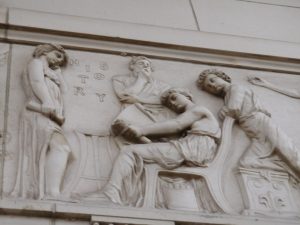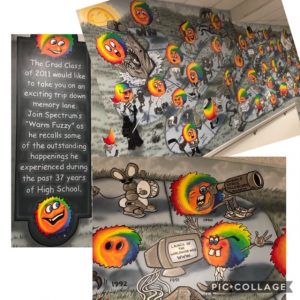
“EdTech Rally 2014” by Kent ISD is licensed under CC BY-SA 2.0
This week both motivated me to continue learning about technology trends and resources in education and immersed me in applications of edtech for my high school students. The first reading from Preparing for the Digital University, gave me incentive to continue learning about emerging technologies by reviewing popular resources in edtech. The second article, What’s next for Ed-Tech? Critical hopes and concerns for the 2020s, considered the challenges and opportunities that are predicted to shape edtech in the next decade. Within this article I found direction for how to equip my students for success in the future with regards to technology. The final reading, A Look at the Future of Open Educational Resources, reviewed technology’s role in helping our students to become content creators, adaptive learners, and active participants in research communities and learning networks.
Preparing for the Digital University: A Review of the History and Current State of Distance, Blended, and Online Learning
In the abstract Preparing for the Digital University, I discovered several compelling reasons for continued research in edtech. I found the introductory statement “Technology infrastructure shapes learning and learning opportunities” profound, and the observation that edtech has matured from emulating teacher generated learning opportunities to student-centered and directed learning opportunities significant. The latter observation convinces me that exploring emerging technologies is imperative in order to productively facilitate such learning opportunities.
This article was fantastic for noting and discussing relevant resources. Of particular interest to me were the following:
- Coursera – open education delivery platform
- gRSShopper – content management system for research – open sourced and free
- Mahara – open-source eportfolio software
- Knewton, Smart Sparrow, OLI, and LoudCloud – competency-based, self regulated, and personalized software
- Federated Wiki – incorporates wiki and blogging
- ProSolo – has self-directed, competency-based, social networking focus
Students and teacher should recognize that the sustainability (and therefor longevity) of these tools are variable and prepare for their closure by backing up their work. This is evidenced by the educational social media platforms Known and Elgg which are mentioned in the article but no longer exist. ‘Link rot’ is not the only pitfall to OER that students and educators should be aware of. OER: lessons from the field raises concerns of data security and privacy, quality of information, furthering the divide between socio-economic groups, and copyright costs and infringement even when using OER.
What’s next for Ed-Tech? Critical hopes and concerns for the 2020’s
Before reading this article I considered what I thought will challenge and shape the next ten years of educational technology, and these are my top 5:
- public school restructuring and funding with respect to providing 1:1 technology tools for public school learners
- union/pay issues and their impact on (quality) teacher recruitment
- professional development in the area of technology
- a loss of foundational skills – perhaps we will need to return to some traditional teaching methods to complement more recent educational innovations and developments (including technology).
- climate change and the impacts of technology
Admittedly, I began reading the second assigned reading by Selwyn, et al. (2019) thinking it would be predictable and irrelevant for the practicing teacher, however I was pleasantly surprised. This paper explained 6 issues that the authors expect to shape educational technology in the next decade:
- New forms of digital in/exclusion: economics
- Platform economics in an age of artificial intelligence: datafication
- Divisions of learning across humans and machines. The authors claim we need to re-establish the value of formal education in light of the affordances of edtech, and “Above all, then, we need to challenge accepted views of what constitutes meaningful and worthwhile knowledge for our future societies.” (pg. 3)
- IT industry actors as a leading educational force. The information in this section is so relevant and important for practicing teachers and education policy makers.
- Reimaging forms of EdTech suitable for an age of climate change
- Finding alternatives: solidary economies, convivial technology, respectful design. This section is so forward thinking and seems so optimistic, however I am not convinced that big companies will release their economic hold on education. But one can always dream…
The authors were so eloquent, thorough and critical in how they presented their ideas I was compelled to look up their credentials and what perspective/interest they may have in edtech. The authors are an impressive list of individuals from around the world:
- Neil Selwyn is a professor in the Faculty of Education, Monash University.
- Thomas Hillman is a senior lecturer at the University of Gothenberg, Sweden.
- Rebecca Eynon is a professor at the Oxford Internet Institute (OII) and the Department of Education at the University of Oxford.
- Giselle Ferreira is a Lecturer at the Department of Education, Pontifical Catholic University of Rio de Janeiro, Brazil.
- Jeremy Knox is a Lecturer in Digital Education at the University of Edinburgh.
-
Felicitas Macgilchrist is Head of the Media | Transformation department and Professor of Media Research at the Georg-August-University of Goettingen’s Institute for International Textbook Research.
-
Juana M. Sancho-Gil is a doctor of Educational Psychology at the University of Barcelona.
This may likely be my favorite reading thus far in my masters program as it motivated me and gave clear direction on how to educate myself in edtech so that I can effectively help prepare my students for our shared future.
A Look at the Future of Open Educational Resources
I have spent time this past week looking at data from the DataBC website to prepare for my upcoming Environmental Science class. This resource has a plethora of data and information dating back for decades (and is being updated regularly). What an excellent source of Open Educational Resources! As noted in A Look at the Future of Open Educational Resources, the use of cloud technologies, open data, artificial intelligence, and decentralized networks result in a model of dynamic and adaptive resources that will be created at the point of need and will draw on constantly changing requirements and data sources…As a result, the emphasis on content publication and licensing will decrease, while questions of access and interoperability will move to the fore.
My concern when looking at all the data provided on the single website, DataBC, I wonder how my students will navigate the immense amount of information that is available to them. How will they find an influential and impactful platform to share their data and is there a more efficient way we can bring these data sets together? As more and more individuals generate their own content, how could/should we either give permission to use and redistribute our content or reject the notion of OER’s and acquire a certificate of copyright? Interestingly, only now am I coming to realize that all the information on the web I currently use for education neither states it is OER, nor does it likely have a certificate of registration of copyright. That is a lot of content that leaves users unsure of whether they are free to reuse, redistribute, or remix the information. It is mentioned in Downes’ article (pg. 5) that Creative commons offers a Certificate course in licensing content. I am interested in taking such a course so that I can provide advise to my students as they continue to progress from consumers to producers of information. I am wondering why this is not currently an elective offered in high school, as many of them have been producing content (on youtube and TikTok for example) for years. I am left with many questions regarding when it becomes important and appropriate to license one’s content.
Finally, I really appreciate the comments
From the pedagogical perspective, the learning happens not through the consumption of the content but through the use of the content. (Siemens, Gašević, Dawson, 2015, p. 5)
and
the philosophy of ‘open science’, where “many of the benefits envisaged for open methods relate to how far they enable not only access but active participation in a research community by newcomers and outsiders, and maintain low barriers to this participation.” (Siemens, Gašević, Dawson, 2015, p. 7)
These quotes reflect my philosophy for my Environmental Science class in particular, and through exploring this way of learning and knowing I hope to further expand upon this teaching philosophy in all my courses.
References
Downes, S. (2019). A Look at the Future of Open Educational Resources. International Journal of Open Educational Resources, 1(2). Retrieved from https://www.ijoer.org/a-look-at-the-future-of-open-educational-resources/
Kaufman, R. and Campana, A. (2019). OER: lessons from the field. Insights, 2019, 32: 15, 1-14. https://insights.uksg.org/articles/10.1629/uksg.464/
Selwyn, N., Hillman, T., Eynon, R., Ferreira, G., Knox, J., Macgilchrist, F., & Sancho-Gil, J. M. (2019). What’s next for Ed-Tech? Critical hopes and concerns for the 2020s. Learning, Media and Technology, 1–6. http://ezproxy.library.uvic.ca/login?url=https://doi.org/10/ggc9w2
Siemens, G., Gašević, D., & Dawson, S. (2015). Preparing for the Digital University: A Review of the History and Current State of Distance, Blended, and Online Learning. Retrieved from Bill & Melinda Gates Foundation website: http://linkresearchlab.org/PreparingDigitalUniversity.pdf

